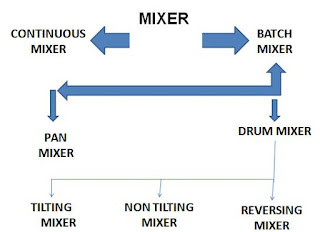A concrete mixer is a device that combines cement, aggregate such as sand or gravel, and water to form concrete. A typical concrete mixer uses a REVOLVING DRUM to mix the components.
FACTORS AFFECTING SELECTION OF MIXER
- LOCATION of the construction site (distance from the batching plant)
- AMOUNT of concrete needed
- CONSTRUCTION SCHEDULE (volume of concrete needed per hour)
- COST (The allocated budget)
- QUALITY of the concrete produced
Types of Mixers
There are two main types of mixers used:
1.batch mixers and
2.continuous mixers.
Batch mixers are the most common.
2.continuous mixers.
Batch mixers are the most common.
Continuous Mixer
- Continuous type mixer produces concrete at a constant rate. In this type, the constituents are continuously entered at one end as the fresh concrete exits the other end.
- They are usually non-tilting drums with screw-type blades rotating in the middle of the drum.
- Two main types of batch mixer can be distinguished by the orientation of the axis of rotation:
2.inclined (drum mixers) or vertical (pan mixers).
The drum mixers have a drum, with fixed blades, rotating around its axis, while the pan mixers may have either the blades or the pan rotating around the axis.
Types of Drum Mixers
- Non-tilting drum mixer.
- Reversing drum mixer.
- Tilting drum mixer.
The non-tilting drum mixer implies that the orientation of the drum is fixed. The materials are added at one end and discharged at the other.
| X-Section of a Non Tilting Mixer |
 |
| X-Section of a Truck Mixer |
- First truck mixer was invented in 1916.
- The reversing drum is similar to the non-tilting mixer except that the same opening is used to add the constituents and to discharge concrete.
- The drum rotates in one direction for mixing and in the opposite direction for discharging the concrete.
- Trucks weigh 20,000 pounds (9,100 kg) to 30,000 pounds (14,000 kg),
- Can carry roughly 40,000 pounds (18,000 kg) of concrete although many varying sizes of Mixer Truck are currently in use.
- Typically the speed for mixing is 1.57 rad/s (15 rpm), while the transport of pre-mixed concrete uses only 0.2 rad/s (2 rpm) to0.6 rad/s (6 rpm).
- Rear discharge truck mixers
- Front discharge truck mixers
"Rear discharge" trucks require both a driver and a "chute man" to guide the truck and chute back and forth to place concrete in the manner suitable to the contractor.
 |
| Rear Discharge Truck |
| Front Discharge Truck |
Tilting mixer
- In this type of mixer axis of the drum does not remain horizontal.
- The position of drum axis for different operations i.e. feeding, mixing and discharge is different.
| Cross Section of a Tilting Mixer |
Pan Mixer
Components of a pan mixer are,
- Pan
- Shaft
- Scraper

